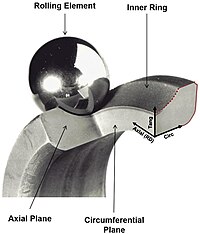
Photo from wikipedia
Abstract Rolling contact fatigue (RCF) is the primary mode of fatigue failure in well-lubricated rolling element bearings. Typical fatigue failures in bearings are characterized by microcrack formation (initiation phase), which… Click to show full abstract
Abstract Rolling contact fatigue (RCF) is the primary mode of fatigue failure in well-lubricated rolling element bearings. Typical fatigue failures in bearings are characterized by microcrack formation (initiation phase), which then coalesce to a large crack that grows to the surface (propagation phase). Hence, RCF is a micromechanical phenomenon driven by microstructural inhomogeneity. This paper presents a coupled damage mechanics - cohesive element method (DM-CEM) to model crack initiation and propagation in polycrystalline material aggregates subject to RCF loading. The material microstructural topology is represented using Voronoi tessellations. The grain boundaries are modeled using cohesive elements. Each grain is composed of cubic anisotropic material and is randomly oriented in material space. A quasi-static Hertzian pressure profile is passed over the surface to simulate a bearing race under dynamic loading. Damage is initiated at the grain boundaries by degradation of the cohesive elements and the rate of damage/degradation is used to characterize the fatigue life evolution. The resulting final spall patterns and fatigue life scatter corroborate well with existing results from open literature. The model was extended and used to demonstrate the feasibility of the Fatemi - Socie criterion as a possible approach for estimating RCF life.
Journal Title: Tribology International
Year Published: 2019
Link to full text (if available)
Share on Social Media: Sign Up to like & get
recommendations!